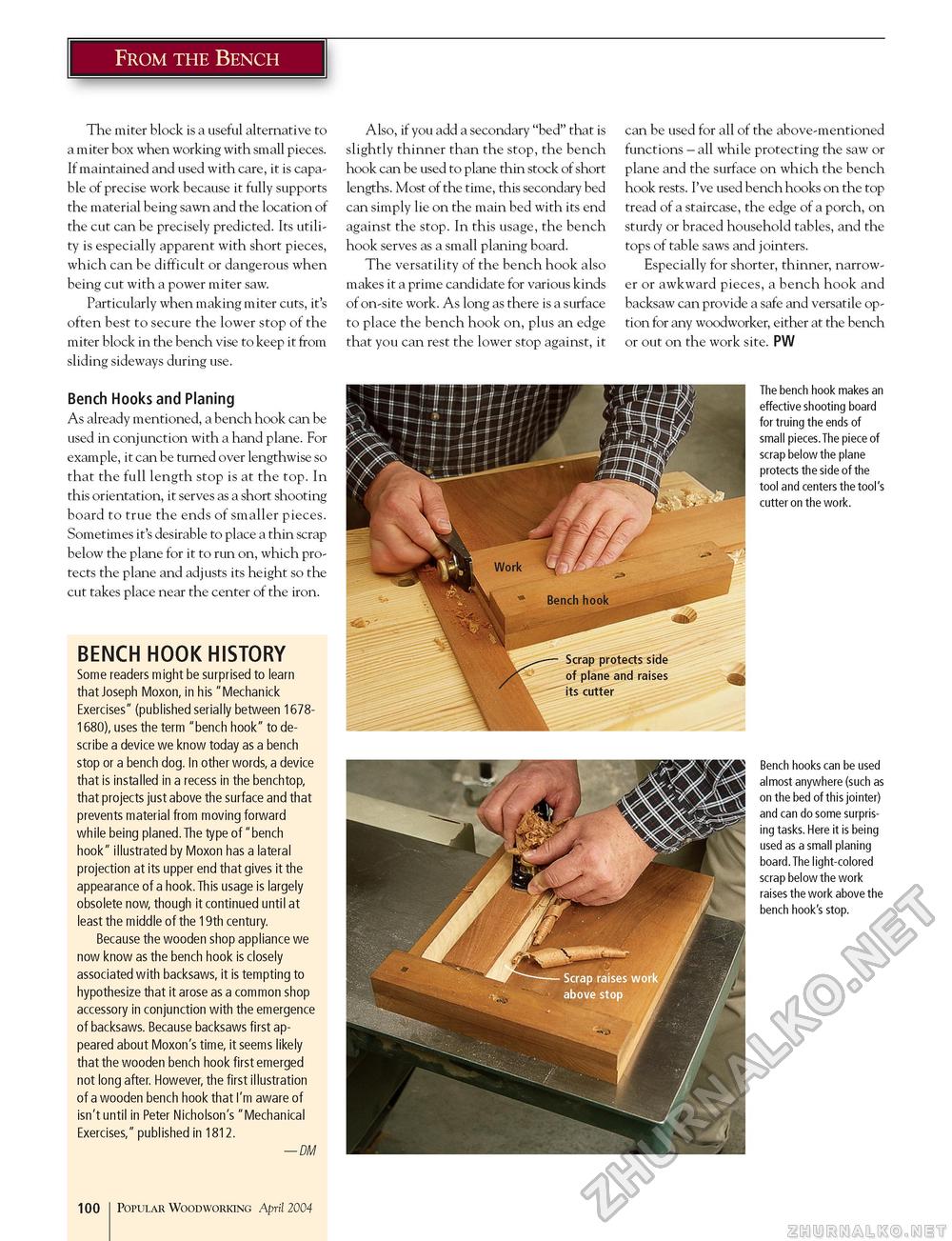Popular Woodworking 2004-04 № 140, страница 103
From the Bench The miter block is a useful alternative to a miter box when working with small pieces. If maintained and used with care, it is capable of precise work because it fully supports the material being sawn and the location of the cut can be precisely predicted. Its utility is especially apparent with short pieces, which can be difficult or dangerous when being cut with a power miter saw. Particularly when making miter cuts, it's often best to secure the lower stop of the miter block in the bench vise to keep it from sliding sideways during use. Bench Hooks and Planing As already mentioned, a bench hook can be used in conjunction with a hand plane. For example, it can be turned over lengthwise so that the full length stop is at the top. In this orientation, it serves as a short shooting board to true the ends of smaller pieces. Sometimes it's desirable to place a thin scrap below the plane for it to run on, which protects the plane and adjusts its height so the cut takes place near the center of the iron. BENCH HOOK HISTORY Some readers might be surprised to learn that Joseph Moxon, in his "Mechanick Exercises" (published serially between 16781680), uses the term "bench hook" to describe a device we know today as a bench stop or a bench dog. In other words, a device that is installed in a recess in the benchtop, that projects just above the surface and that prevents material from moving forward while being planed.The type of "bench hook" illustrated by Moxon has a lateral projection at its upper end that gives it the appearance of a hook. This usage is largely obsolete now, though it continued until at least the middle of the 19th century. Because the wooden shop appliance we now know as the bench hook is closely associated with backsaws, it is tempting to hypothesize that it arose as a common shop accessory in conjunction with the emergence of backsaws. Because backsaws first appeared about Moxon's time, it seems likely that the wooden bench hook first emerged not long after. However, the first illustration of a wooden bench hook that I'm aware of isn't until in Peter Nicholson's "Mechanical Exercises," published in 1812. —DM Also, if you add a secondary "bed" that is slightly thinner than the stop, the bench hook can be used to plane thin stock of short lengths. Most of the time, this secondary bed can simply lie on the main bed with its end against the stop. In this usage, the bench hook serves as a small planing board. The versatility of the bench hook also makes it a prime candidate for various kinds of on-site work. As long as there is a surface to place the bench hook on, plus an edge that you can rest the lower stop against, it can be used for all of the above-mentioned functions - all while protecting the saw or plane and the surface on which the bench hook rests. I've used bench hooks on the top tread of a staircase, the edge of a porch, on sturdy or braced household tables, and the tops of table saws and jointers. Especially for shorter, thinner, narrower or awkward pieces, a bench hook and backsaw can provide a safe and versatile option for any woodworker, either at the bench or out on the work site. PW The bench hook makes an effective shooting board for truing the ends of small pieces.The piece of scrap below the plane protects the side of the tool and centers the tool's cutter on the work. Bench hooks can be used almost anywhere (such as on the bed of this jointer) and can do some surprising tasks. Here it is being used as a small planing board.The light-colored scrap below the work raises the work above the bench hook's stop. 100 Popular Woodworking April 2004 |








